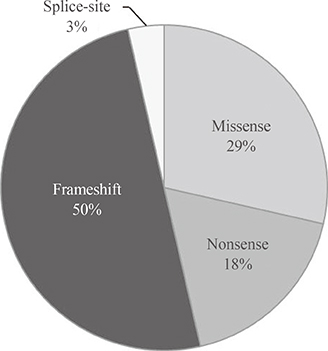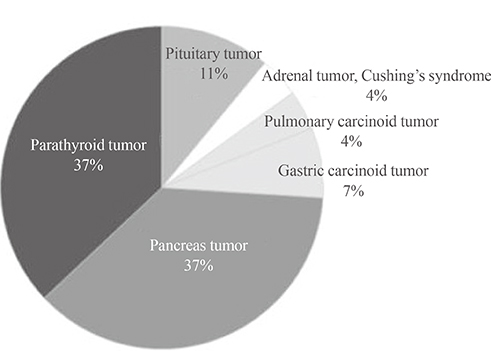Endocrinol Metab.
2014 Sep;29(3):270-279. 10.3803/EnM.2014.29.3.270.
Genetic and Epigenetic Analysis in Korean Patients with Multiple Endocrine Neoplasia Type 1
- Affiliations
-
- 1Department of Internal Medicine, Endocrine Research Institute, Severance Hospital, Yonsei University College of Medicine, Seoul, Korea. yumie@yuhs.ac
- 2Brain Korea 21 Project for Medical Science, Yonsei University College of Medicine, Seoul, Korea.
- 3Department of Surgery, Yonsei University College of Medicine, Seoul, Korea.
- 4Department of Pathology, Yonsei University College of Medicine, Seoul, Korea.
- KMID: 2169463
- DOI: http://doi.org/10.3803/EnM.2014.29.3.270
Abstract
- BACKGROUND
Multiple endocrine neoplasia type 1 (MEN1) is a familial syndrome characterized by the parathyroid, pancreas and pituitary tumors. Parathyroid tumors are the most common clinical manifestations, occurring in more than 90% of MEN1 patients. Heterozygous germline mutations of the MENIN gene underlie the tumorigenesis in MEN1 and epigenetic alterations along with germline mutations may contribute to tumorigenesis. Here, we investigated the associations between genotype and phenotype in Korean MEN1 patients.
METHODS
We analyzed medical records from 14 unrelated MEN1 patients who had newly confirmed MENIN germline mutations, together with 14 previous reports in Korea. Aberrant DNA methylations were also examined in MEN1-related parathyroid tumors using the Infinium HumanMethylation 450 BeadChip.
RESULTS
Total 28 germline mutations of MENIN were relatively highly concentrated in exons 7 and 8 compared to previous reports from Western countries. Six mutations (c.111dupT/p.S38Ffs*79, c.225_226insT/p.T76Yfs*41, c.383_398del16/p.S128Tfs*52, c.746dupT/p.H250Afs*20, c.1150G>T/p.E384*, and c.1508G>A/p.G503N) were newly found in the present study. Of interest, four patients (15%) showed unusual initial presentations and three patients were diagnosed incidentally at the general medical checkup. We also found three distinct sites in exon 2 of MENIN were significantly hypomethylated in the MEN1 parathyroid tumors, comparing correspondent blood samples.
CONCLUSION
We also have found a lack of genotype/phenotype correlation in Korean MEN1 patients. There were not a few unusual initial manifestations in MEN1 patients, thus, genetic testing for the MENIN germline mutations can provide important information for the better prognosis. Further studies are warranted to investigate altered DNA methylations in the MENIN gene involved in tumorigenesis.
MeSH Terms
Figure
Cited by 1 articles
-
Genetic Landscape and Clinical Manifestations of Multiple Endocrine Neoplasia Type 1 in a Korean Cohort: A Multicenter Retrospective Analysis
Boram Kim, Seung Hun Lee, Chang Ho Ahn, Han Na Jang, Sung Im Cho, Jee-Soo Lee, Yu-Mi Lee, Su-Jin Kim, Tae-Yon Sung, Kyu Eun Lee, Woochang Lee, Jung-Min Koh, Moon-Woo Seong, Jung Hee Kim
Endocrinol Metab. 2024;39(6):956-964. doi: 10.3803/EnM.2024.2008.
Reference
-
1. Hoff AO, Cote GJ, Gagel RF. Multiple endocrine neoplasias. Annu Rev Physiol. 2000; 62:377–411.2. Lemos MC, Thakker RV. Multiple endocrine neoplasia type 1 (MEN1): analysis of 1336 mutations reported in the first decade following identification of the gene. Hum Mutat. 2008; 29:22–32.3. Thakker RV. Multiple endocrine neoplasia type 1 (MEN1). Best Pract Res Clin Endocrinol Metab. 2010; 24:355–370.4. Oh KY, Lee NS, Jang DS, You KH, Baek HS. Multiple endocrine neoplasm type I: a case report. Korean J Intern Med. 1986; 31:229–235.5. Chandrasekharappa SC, Guru SC, Manickam P, Olufemi SE, Collins FS, Emmert-Buck MR, Debelenko LV, Zhuang Z, Lubensky IA, Liotta LA, Crabtree JS, Wang Y, Roe BA, Weisemann J, Boguski MS, Agarwal SK, Kester MB, Kim YS, Heppner C, Dong Q, Spiegel AM, Burns AL, Marx SJ. Positional cloning of the gene for multiple endocrine neoplasia-type 1. Science. 1997; 276:404–407.6. Guru SC, Manickam P, Crabtree JS, Olufemi SE, Agarwal SK, Debelenko LV. Identification and characterization of the multiple endocrine neoplasia type 1 (MEN1) gene. J Intern Med. 1998; 243:433–439.7. Wautot V, Vercherat C, Lespinasse J, Chambe B, Lenoir GM, Zhang CX, Porchet N, Cordier M, Beroud C, Calender A. Germline mutation profile of MEN1 in multiple endocrine neoplasia type 1: search for correlation between phenotype and the functional domains of the MEN1 protein. Hum Mutat. 2002; 20:35–47.8. Kouvaraki MA, Lee JE, Shapiro SE, Gagel RF, Sherman SI, Sellin RV, Cote GJ, Evans DB. Genotype-phenotype analysis in multiple endocrine neoplasia type 1. Arch Surg. 2002; 137:641–647.9. Starker LF, Svedlund J, Udelsman R, Dralle H, Akerstrom G, Westin G, Lifton RP, Bjorklund P, Carling T. The DNA methylome of benign and malignant parathyroid tumors. Genes Chromosomes Cancer. 2011; 50:735–745.10. Zhang M, Xu C, von Wettstein D, Liu B. Tissue-specific differences in cytosine methylation and their association with differential gene expression in sorghum. Plant Physiol. 2011; 156:1955–1966.11. Choi H, Kim S, Moon JH, Lee YH, Rhee Y, Kang ES, Ahn CW, Cha BS, Lee EJ, Kim KR, Lee HC, Jeong SY, Kim HJ, Lim SK. Multiple endocrine neoplasia type 1 with multiple leiomyomas linked to a novel mutation in the MEN1 gene. Yonsei Med J. 2008; 49:655–661.12. Choi JH, Kim HI, Kang SM, Kim SG, Oh HK, Bae SH, Ryoo HM. A case of a calcitonin-secreting pancreatic endocrine tumor in a pateint with multiple endocrine neoplasia type 1. Korean J Med. 2012; 83:817–822.13. Park SE, Kang ES, Lee HJ, Kim SH, Do MY, Kang SA, Han SJ, Kim HJ, Ahn CW, Cha BS, Lim SK, Kim KR, Kim IJ, Lee HC. A case of multiple endocrine neoplasia type 1 with mutation in MENIN gene. J Korean Soc Endocrinol. 2005; 20:71–77.14. Sung HY, Chun YJ, Lee H, Kwon BJ, Park KW, Lee JM, Moon SD, Chang SA, Han JH. A case of familial multiple endocrine neoplasia with MEN1 gene mutation. J Korean Endocr Soc. 2006; 21:560–566.15. Park JH, Kim IJ, Kang HC, Lee SH, Shin Y, Kim KH, Lim SB, Kang SB, Lee K, Kim SY, Lee MS, Lee MK, Park JH, Moon SD, Park JG. Germline mutations of the MEN1 gene in Korean families with multiple endocrine neoplasia type 1 (MEN1) or MEN1-related disorders. Clin Genet. 2003; 64:48–53.16. Kim MJ, Kim EH, Shin MS, Kim JH, Na HK, Park SJ, Lee SA, Koh EH, Lee WJ, Song KH, Park JY, Lee KU, Kim GH, Yoo HW, Kim MS. A case of familial multiple endocrine neoplasia type 1 with a novel mutation in the MEN1 gene. Endocrinol Metab. 2011; 26:171–176.17. Jo YE, Choi YJ, Kim YK, Ahn SM, Jung SH, Kim HJ, Kim DJ, Lee KW, Hong JH, Jeong SY, Kim HJ, Chung YS. A case of familial multiple endocrine neoplasia type 1 with MEN1 gene mutation. J Korean Endocr Soc. 2007; 22:68–73.18. Choi YS, Bai YS, Ku BJ, Jo YS, Kim YK, Ro HK, Shong M. A case of multiple endocrine neoplasia type I with atypical clinical course. J Korean Endocr Soc. 2008; 23:266–271.19. Sim YS, Lee JH, Moon JW, Oh JY, Kim YK, Sung SH, Chang JH. A case of multiple endocrine neoplasia type 1 with pulmonary large cell neuroendocrine carcinoma. Korean J Med. 2007; 72:Suppl 2. S214–S220.20. Cho PS, Park H, Lee GH, Lee MC. A case of asymptomatic multiple endocrine neoplasia type 1 detected incidentally on health screening. Korean J Otorhinolaryngol-Head Neck Surg. 2012; 55:373–377.21. Lee SW, Choi YS, Park YH, Oh KS, Shin JW, Kim IJ, Uchino S. A case of multiple endocrine neoplasia associated with VIPoma. J Korean Soc Endocrinol. 2005; 20:64–70.22. Brandi ML, Gagel RF, Angeli A, Bilezikian JP, Beck-Peccoz P, Bordi C, Conte-Devolx B, Falchetti A, Gheri RG, Libroia A, Lips CJ, Lombardi G, Mannelli M, Pacini F, Ponder BA, Raue F, Skogseid B, Tamburrano G, Thakker RV, Thompson NW, Tomassetti P, Tonelli F, Wells SA Jr, Marx SJ. Guidelines for diagnosis and therapy of MEN type 1 and type 2. J Clin Endocrinol Metab. 2001; 86:5658–5671.23. Kim M, Park YK, Kang TW, Lee SH, Rhee YH, Park JL, Kim HJ, Lee D, Lee D, Kim SY, Kim YS. Dynamic changes in DNA methylation and hydroxymethylation when hES cells undergo differentiation toward a neuronal lineage. Hum Mol Genet. 2014; 23:657–667.24. Jiang XH, Lu JL, Cui B, Zhao YJ, Wang WQ, Liu JM, Fang WQ, Cao YN, Ge Y, Zhang CX, Casse H, Li XY, Ning G. MEN1 mutation analysis in Chinese patients with multiple endocrine neoplasia type 1. Endocr Relat Cancer. 2007; 14:1073–1079.25. Balogh K, Hunyady L, Patocs A, Gergics P, Valkusz Z, Toth M, Racz K. MEN1 gene mutations in Hungarian patients with multiple endocrine neoplasia type 1. Clin Endocrinol (Oxf). 2007; 67:727–734.26. Pieterman CR, van Hulsteijn LT, den Heijer M, van der Luijt RB, Bonenkamp JJ, Hermus AR, Borel Rinkes IH, Vriens MR, Valk GD. DutchMEN1 Study Group. Primary hyperparathyroidism in MEN1 patients: a cohort study with longterm follow-up on preferred surgical procedure and the relation with genotype. Ann Surg. 2012; 255:1171–1178.27. Eller-Vainicher C, Chiodini I, Battista C, Viti R, Mascia ML, Massironi S, Peracchi M, D'Agruma L, Minisola S, Corbetta S, Cole DE, Spada A, Scillitani A. Sporadic and MEN1-related primary hyperparathyroidism: differences in clinical expression and severity. J Bone Miner Res. 2009; 24:1404–1410.28. Schaefer S, Shipotko M, Meyer S, Ivan D, Klose KJ, Waldmann J, Langer P, Kann PH. Natural course of small adrenal lesions in multiple endocrine neoplasia type 1: an endoscopic ultrasound imaging study. Eur J Endocrinol. 2008; 158:699–704.29. Skogseid B, Larsson C, Lindgren PG, Kvanta E, Rastad J, Theodorsson E, Wide L, Wilander E, Oberg K. Clinical and genetic features of adrenocortical lesions in multiple endocrine neoplasia type 1. J Clin Endocrinol Metab. 1992; 75:76–81.30. Vithian K, Shaafi K, Russell S. Multiple endocrine neoplasia type 1 and adrenal Cushing's. JRSM Short Rep. 2011; 2:10.31. Alzahrani AS, Al-Khaldi N, Shi Y, Al-Rijjal RA, Zou M, Baitei EY, Amin T. Diagnosis by serendipity: Cushing syndrome attributable to cortisol-producing adrenal adenoma as the initial manifestation of multiple endocrine neoplasia type 1 due to a rare splicing site MEN1 gene mutation. Endocr Pract. 2008; 14:595–602.32. Desai D, McPherson LA, Higgins JP, Weigel RJ. Genetic analysis of a papillary thyroid carcinoma in a patient with MEN1. Ann Surg Oncol. 2001; 8:342–346.33. Dong Q, Debelenko LV, Chandrasekharappa SC, Emmert-Buck MR, Zhuang Z, Guru SC, Manickam P, Skarulis M, Lubensky IA, Liotta LA, Collins FS, Marx SJ, Spiegel AM. Loss of heterozygosity at 11q13: analysis of pituitary tumors, lung carcinoids, lipomas, and other uncommon tumors in subjects with familial multiple endocrine neoplasia type 1. J Clin Endocrinol Metab. 1997; 82:1416–1420.34. Wautot V, Khodaei S, Frappart L, Buisson N, Baro E, Lenoir GM, Calender A, Zhang CX, Weber G. Expression analysis of endogenous menin, the product of the multiple endocrine neoplasia type 1 gene, in cell lines and human tissues. Int J Cancer. 2000; 85:877–881.35. McKeeby JL, Li X, Zhuang Z, Vortmeyer AO, Huang S, Pirner M, Skarulis MC, James-Newton L, Marx SJ, Lubensky IA. Multiple leiomyomas of the esophagus, lung, and uterus in multiple endocrine neoplasia type 1. Am J Pathol. 2001; 159:1121–1127.36. Vortmeyer AO, Lubensky IA, Skarulis M, Li G, Moon YW, Park WS, Weil R, Barlow C, Spiegel AM, Marx SJ, Zhuang Z. Multiple endocrine neoplasia type 1: atypical presentation, clinical course, and genetic analysis of multiple tumors. Mod Pathol. 1999; 12:919–924.37. Pannett AA, Thakker RV. Somatic mutations in MEN type 1 tumors, consistent with the Knudson "two-hit" hypothesis. J Clin Endocrinol Metab. 2001; 86:4371–4374.38. Brenet F, Moh M, Funk P, Feierstein E, Viale AJ, Socci ND, Scandura JM. DNA methylation of the first exon is tightly linked to transcriptional silencing. PLoS One. 2011; 6:e14524.
- Full Text Links
- Actions
-
Cited
- CITED
-
- Close
- Share
- Similar articles
-
- Scintigraphic evaluation of multiple endocrine neoplasia type 2 (MEN type 2)
- Multiple Endocrine Neoplasia and Familial Medullary Thyroid Carcinoma
- Imaging Finding of Multiple Endocrine Neoplasia Type 1: Case Report
- Multiple Endocrine Neoplasia Type 2B Diagnosed Early by Conjunctival Neuroma: a Case Report
- A Case of Multiple Endocrine Neoplasia type 3 With Multiple Mucosal Neuroma





